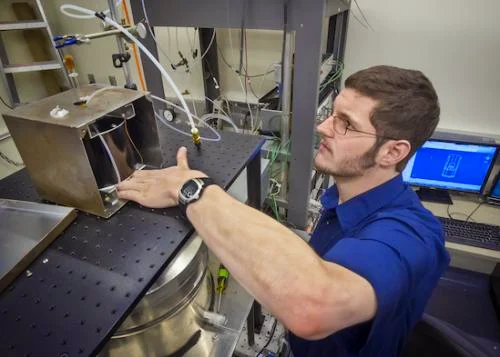Earth's magnetic field, a familiar directional indicator over long distances, is routinely probed in applications ranging from geology...
Earth's magnetic field, a familiar directional indicator over long distances, is routinely probed in applications ranging from geology to archaeology. Now it has provided the basis for a technique which might, one day, be used to characterize the chemical composition of fluid mixtures in their native environments.
 |
| A schematic illustration of Earth's magnetic field. Credit: NASA-Credit/Copyright: Peter Reid, The University of Edinburgh. |
Researchers from the U.S. Department of Energy (DOE)'s Lawrence Berkeley National Laboratory (Berkeley Lab) conducted a proof-of-concept NMR experiment in which a mixture of hydrocarbons and water was analyzed using a high-sensitivity magnetometer and a magnetic field comparable to that of the Earth.
The work was conducted in the NMR laboratory of Alexander Pines, one of the world's foremost NMR authorities, as part of a long-standing collaboration with physicist Dmitry Budker at the University of California, Berkeley, along with colleagues at the National Institute of Standards and Technology (NIST). The work will be featured on the cover of Angewandte Chemie and is published in a paper titled "Ultra-Low-Field NMR Relaxation and Diffusion Measurements Using an Optical Magnetometer." The corresponding author is Paul Ganssle, who was a PhD student in Pines' lab at the time of the work.
"This fundamental research program seeks to answer a broad question: how can we sense the interior chemical and physical attributes of an object at a distance, without sampling it or encapsulating it?" says Vikram Bajaj, a principal investigator in Pines' group. "A particularly beautiful aspect of magnetic resonance is its ability to gently peer within intact objects, but it's tough to do that from far away."
High-field and low-field NMR
The exquisite sensitivity of NMR for detecting chemical composition, and the spatial resolution which it can provide in medical applications, requires large and precise superconducting magnets. These magnets are expensive and immobile. Further, the sample of interest must be placed inside the magnet, such that the entire sample is exposed to a homogeneous magnetic field. This well-developed method is called high-field NMR. The sensitivity of high-field NMR is proportional to magnetic field strength.
But chemical characterization of objects that cannot be placed inside a magnet requires a different approach. In ex situ NMR measurements, the geometry of a typical high-field experiment is reversed such that the detector probes the sample surface, and the magnetic field is projected into the object. A main challenge with this situation is generating a homogeneous magnetic field over a sufficiently large sample area: it is not feasible to generate field strengths necessary to make conventional high-resolution NMR measurements.
Instead of a superconducting magnet, low-field NMR measurements may rely on Earth's magnetic field, given a sufficiently sensitive magnetometer.
"One nice thing about Earth's magnetic field is that it's very homogeneous," explains Ganssle. "The problem with its use in inductively-detected MRI [MRI – magnetic resonance imaging – is NMR's technological sibling] is that you need a magnetic field that's both strong and homogeneous, so you need to surround the whole subject with superconducting coils, which is not something that's possible in an application like oil-well logging."
 |
| Paul Ganssle is the corresponding author of a paper in Angewandte Chemie describing the ultra-low-field NMR using an optical magnetometer. Credit: Roy Kaltschmidt, Berkeley Lab |
"Sensitivity of magnetic resonance depends profoundly on the magnetic field, because the field causes the detected spins to align slightly," adds Bajaj. "The stronger the applied field, the stronger the signal, and the higher its frequency, which also contributes to the detection sensitivity."
Earth's magnetic field is indeed very weak, but optical magnetometers can serve as detectors for ultra-low-field NMR measurements in the ambient field alone without any permanent magnets. This means that ex-situ measurements lose chemical sensitivity due to field strength alone. But this method offers other advantages.
Read More>>


No comments